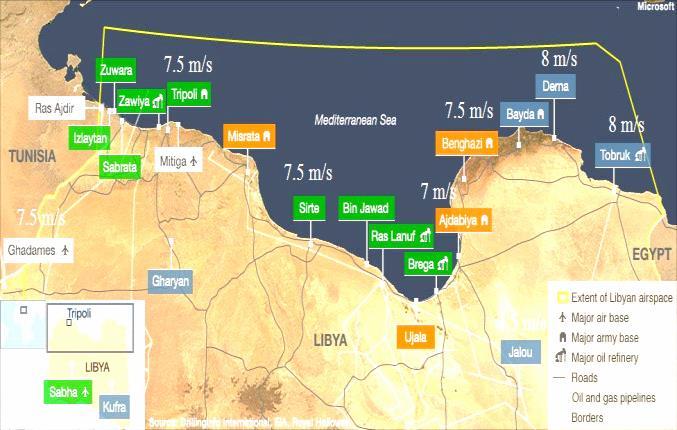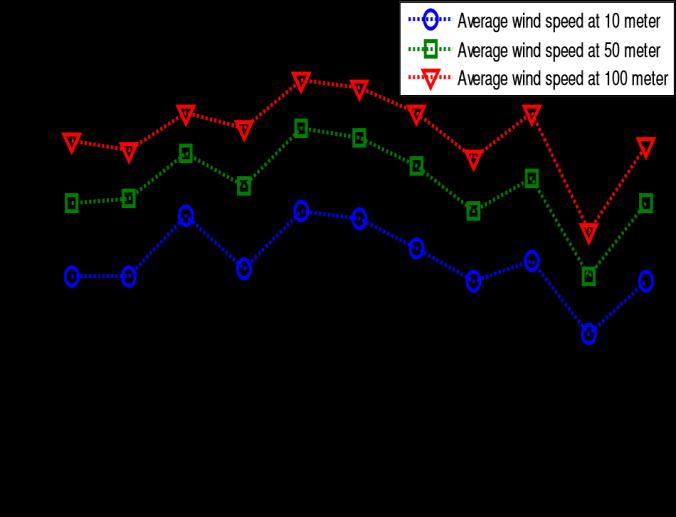
International Research Journal of Engineering and Technology (IRJET) e-ISSN: 2395-0056
Volume: 12 Issue: 01 | Jan 2025 www.irjet.net p-ISSN: 2395-0072


International Research Journal of Engineering and Technology (IRJET) e-ISSN: 2395-0056
Volume: 12 Issue: 01 | Jan 2025 www.irjet.net p-ISSN: 2395-0072
Abdulhamid Y albas
Dept. of mechanical Engineering, Higher Institute of Science and Technology, Cyrene, Libya
Abstract - The motivation for the work discussed herein stems from the increasing demand for renewable energy and the declining supply of nonrenewable energy. A growing proportion of global energy production is transitioning to renewable sources. Wind energy is experiencing heightened implementation for power generation owing to its economic advantages. Libya possesses a wealth of renewable energy resources, with an average wind speed of 4.5 m/s at 10 meters and 8 m/s at 50 meters. The economic study of this plant indicates that the wind farm incurs an investment cost of $3,450,000, yielding annual savings of $499,826.70. The payback period was determined to be 7 years, the savings-toinvestment ratio was computed at 3.62, the net present value was positive, and the return on investment was 14.4%
Key Words: wind plant, economic analysis, turbine, greenhousegases,renewableenergy
1.INTRODUCTION
Energyneedshavesignificantlyexpandedas aresultofthe world economy's rapid development, particularly in emerging nations. Interest in using renewable energy has grown as a result of the understanding that the resources needed to generate energy from fossil fuels are becoming finite and that carbon emissions into the atmosphere are linkedtoclimatechange[1].Thedevelopmentofapollutionfree, renewable wind system is essential. North Africa is home to Libya, which shares borders with Algeria, West Tunisia, South Africa, South Sudan, East Egypt, the Mediterranean, and southern Chad and Niger. The population grew by 1.3% annually in 2019 after reaching roughly 637500 in 2018[2]. Libya is the fourth largest country in Africa with an area of 1.75 million square kilometers,and itranks17thasthelargestcountry inthe world, and most of its lands are shrubs, desert, and semidesert [3]. Generally speaking, the average wind speed in Libyaisbetween5and10meterspersecond.InLibya,one oftheprimarybenefitsofwindenergyisthatitcanmeetthe demandforelectricityinmostareas.Therefore,itisessential to create a new and remarkably amazing technical innovationindustryinordertoreduceglobalwarmingand thepollutantslinkedtoenergyuse.Butwindtechnologyis becomingmoreandmoreattractive.Therearehourly,daily, and yearly variations in wind energy output. Therefore, directpoweringloadsthatneedaconsistentandcontinuous inputenergysupplyisnotagoodfitforwindturbines.
1.1Energy policy of Libya
Libya'senergysectordependsmoreonimportedfossilfuel. Increaseelectricitypercapitaconsumptionbyanaverageof 2.7,5,and4.7MWhbetween2002and2018[2].Unpredicted costsofthisfuel,coupledwithanincreaseinglobalwarming associated with thermal plants, pose a great danger in the energysector.Tocomplementthis,renewableenergysources needtobeharnessedforelectricitygeneration.
Quantifyingseveralkeyfeaturesofthewindisnecessaryto effectivelymapitsresource.Primarily,andmostsignificantly, thevelocity,
We must precisely measure the wind over a minimum duration of one full year. Secondly, we must analyze the originofthewind'sdirection.Finally,thevariationinwind speed as a function of altitude must be examined to understandhowwindspeedmeasurementswillbeadjusted wheninterpolatedwiththewindturbinehubheight[4].
Windenergyisthesecondbestalternativerenewableenergy source.ThewindspeedinsomecoastalcitiesisshowninFig -1. The average wind speed at three different heights in differentcitiesinLibyaisshowninChart-1.


International Research Journal of Engineering and Technology (IRJET) e-ISSN: 2395-0056
Volume: 12 Issue: 01 | Jan 2025 www.irjet.net p-ISSN: 2395-0072

Chart -1:Themonthlyaveragewindspeedindifferent citiesinLibya[2]
Windturbinesareavailableindifferent specifications. We selected Raum wind turbines for thisstudy. Thetable belowdisplaysthespecificationsofthisturbine
Table -1: windturbinespecifications[5]
Table -2: poweroutputfromasingleturbine[5]
Fromtheresultsobtainedabove,eachwindturbinecan produceanexpectedtotalenergyof1409.4kWh.However, forawindturbineof3Mw,2200windturbinesarerequired. Landrequirementtheexpectedlandareafortheinstallation ofthewindturbinecanbecalculatedasfollows
Poweroutput=2200(1408.4)0.85=3098480kWh/year
Pav/m2 =powerdensity/320=76.43/320=0.2388
0.2388×8760=2.092kWh/m2/year
Landrequirement=3098480/2.092=1481109m
The investment cost of a wind farm fluctuates based on turbine size and other project-related expenses. The estimated range is from $900/kW to $1150/kW [4]. Alternativesourcesindicatethatthecostmayreachashigh as$1308/kWto$1400/kW.Weassumed$1100perkWfor thispaper.Theassumedgenerationcostis18centsperkWh, as the generation cost for an onshore wind farm varies between14and18centsperkWh[4].Theanalysisassumes adiscountrateof12%andaprojectlifespanof25years.The calculationoftheinvestmentcostis 3000 * 1150 = $3,450,000. The annual generation cost is calculatedtobe$499,8267
Weusethismetrictocalculatehowlongitwilltaketo recovertheinitialinvestmentinacost-savinginitiative.
SPP=investment/saving=3450000/499,826.7=7years
Oftheprojectafter25yearscanbeestimatedas P=A×[P/A,I,N],Where A=Annualsavings, P=Presentvalue, I=Discountrate, N=Numberofyear. P=499,826.7×[7.8431]=3920190.8

International Research Journal of Engineering and Technology (IRJET) e-ISSN: 2395-0056
Volume: 12 Issue: 01 | Jan 2025 www.irjet.net p-ISSN: 2395-0072
NPV=A×[P/A,I,N]–presentvaluecost
NPV=3920190.8-3,450,000=470190.8
Savingtoinvestmentratio(SIR):Thiscalculatethepresent worth of all benefits, then calculate worth of all costs and takestheratioofthetwosums.
SIR=lifetimesaving/investmentcost
SIR=[499,826.7*25]/3450000=3.62
It is the inverse of the simple payback period given as a percentage.Itprovidestheannualproportionofinvestment coststhatwillberecoupedthroughsavings. [saving/investment]*100=[499,826.7/3450000]*100 =14.48%.
Therotationofthewindturbine'spropellersgeneratesnoise thatmaydisruptnearbyresidents.Thepropellermayalso lethallyimpactbirdsinthevicinity.Nonetheless,thepower plant will diminish greenhouse gas emissions linked to thermalfacilities.
Thispaperdescribesa3MWwindfarmlocatedinLibya. Theeconomicstudyindicatesthatthewindfarmincursan investment cost of $3,450,000, yielding annual savings of $499,826.70. The payback period was determined to be 7 years,thesavings-to-investmentratiowascomputedat3.62, the net present value was positive, and the return on investment was 14.48%. The results indicate that a wind farmisviableinLibya,withsignificantannualsavingsanda reasonable payback period. Furthermore, it was demonstrated that the facility will diminish the output of greenhousegases.
[1] Lee and Chen, (2009) ” Wind-photovoltaic capacity coordination for a time-of-use rate industrial user”, IET Renewable Power Generation, volume 3(2), page no-152167.
[2]D. Moria and M.Elmnifi, (2020)“Feasibility study into possibilitypotentialsandchallengesofrenewableenergyin Libya”, International Journal of Advanced Science and Technology,volume29(3),pageno-12546-12560.
[3] W.Yahya,A.Nassar,F.A.Mansur,M.Al-Nehari,andM.M. Alnakhlani, (2020) “Future study of renewable energy in Libya”, International Journal of Advanced Engineering ResearchandScience(IJAERS),volume7(10),pageno1-6.
[4] J.F. Manwell, J.G. McGowan and A.L. Rogers, (2010) “ Windenergyexplained:theory,designandapplication”.John Wiley&Sons.
[5] A. Aliyu, G. Muhammed, and I. Abdullahi, (2017) “InstallationOf2MWWindPowerPlantInNorthernCyprus: Technical, Economical And Environmental Analysis” International Journal of Scientific & Technology Research, volume6(1),pageno5-7.